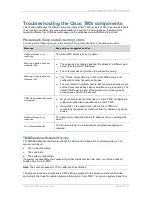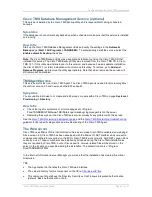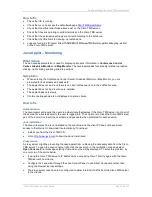
Troubleshooting the Cisco TMS components
Cisco TMS Administration Guide
Page 29 of 37
TMSPLCMDirectoryService
This service is responsible for posting phonebooks to Polycom endpoints. The PLCM endpoint
retrieves the phonebook from this service when requested via the remote control. This is similar to
Corporate Directory in Cisco endpoints.
Symptoms
You don’t get any phonebooks on your Polycom endpoints
How to fix
1. Check the logs for symptoms or error messages at c:\Program
Files\TANDBERG\TMS\wwwTMS\Data\Logs\tmsdebug\log-plcmdir.txt on the server.
2. Restarting the service or the Cisco TMS server will normally fix any problem with this service.
TMSSchedulerService
This service is responsible for launching events at set times. Examples of events are:
System Restore
System Upgrade
Update Phonebooks
This service will also remind the TMSLiveService to start a conference if needed.
Note: TMSLiveService will keep track of all booked conferences, but loose this information if it is
restarted.
Symptoms
Scheduled events do not start.
How to fix
1. Check the logs for symptoms or error messages at c:\Program
Files\TANDBERG\TMS\wwwTMS\Data\Logs\tmsdebug\log-schedulerservice.txt on the server.
2. Restarting the service or the Cisco TMS server will normally fix any problem with this service.
TMSSnmpService (formerly TMSWatchdogServiceStarter.exe)
This service should be turned off if you have Cisco TMS set to HTTPS only. For more information, see
Implementing Secure Management
.
The service
collects traps from the endpoints and adds them directly to the database.
is responsible for broadcasting SNMP messages to discover newly added systems.
1. To specify the sub ranges for where TMSSnmpService searches for new endpoints, go to
Administrative Tools > Network Settings > SNMP Broadcast/Multicast Address(es).
2. To specify the SNMP Broadcast Interval, go to Administrative Tools > Network Settings >
SNMP Broadcast Interval (in minutes). Cisco recommends setting SNMP Broadcast Interval
to broadcast 2 times a day depending on video network size. Define multiple scan ranges by
comma separating the ranges. By setting the Broadcast/Multicast Address value to 127.0.0.1,
Cisco TMS will not scan for new systems via SNMP broadcast.
To quickly find which systems are online, you can use the TMSSnmpService and send SNMP Oid
queries to systems that:
3. are known to Cisco TMS























